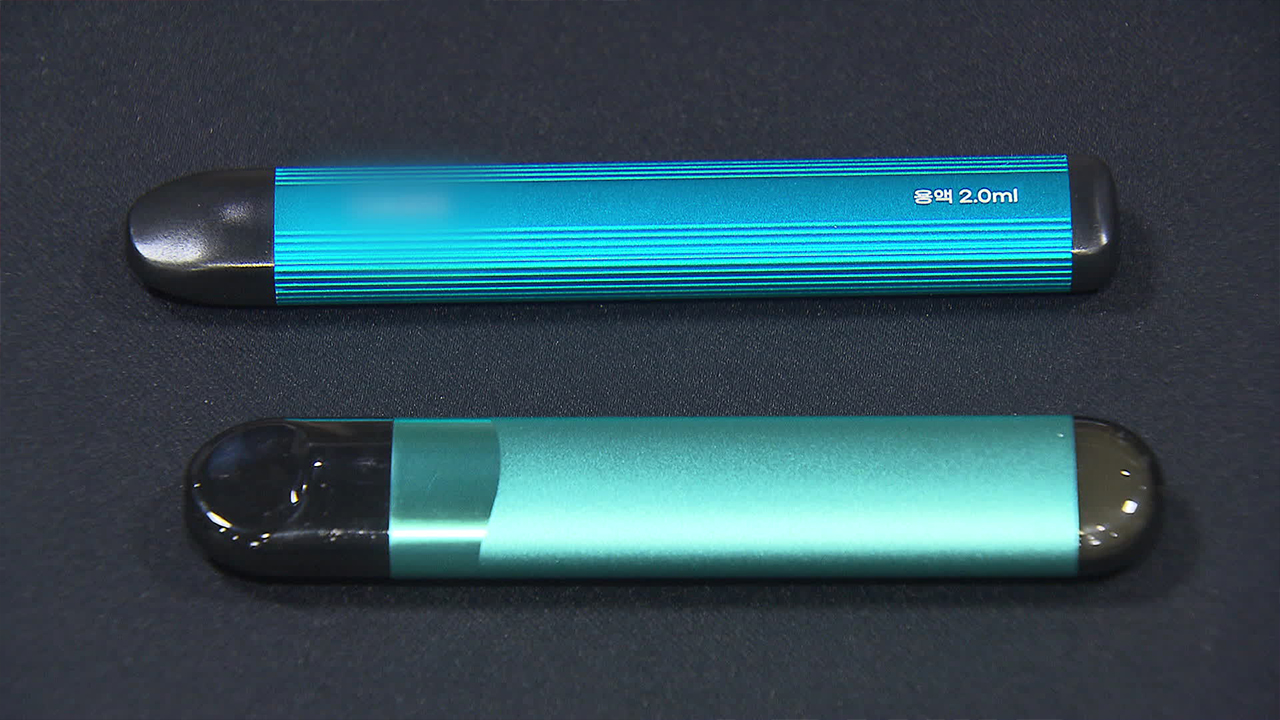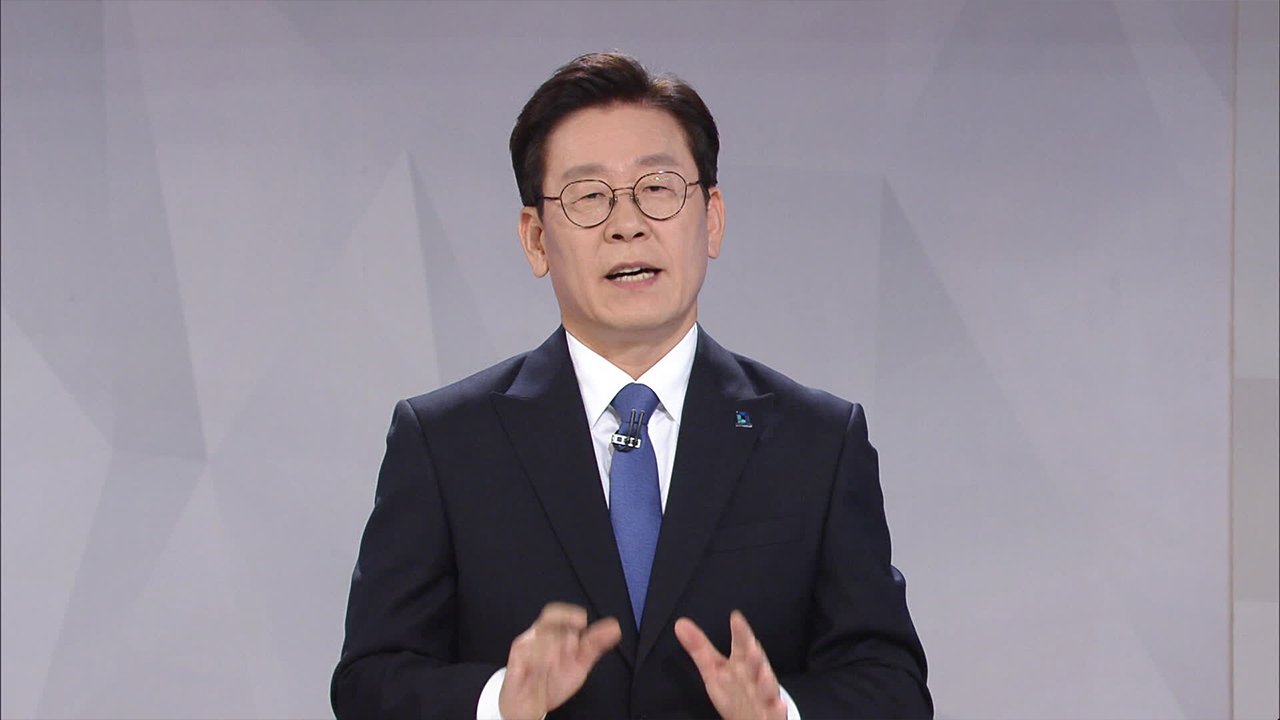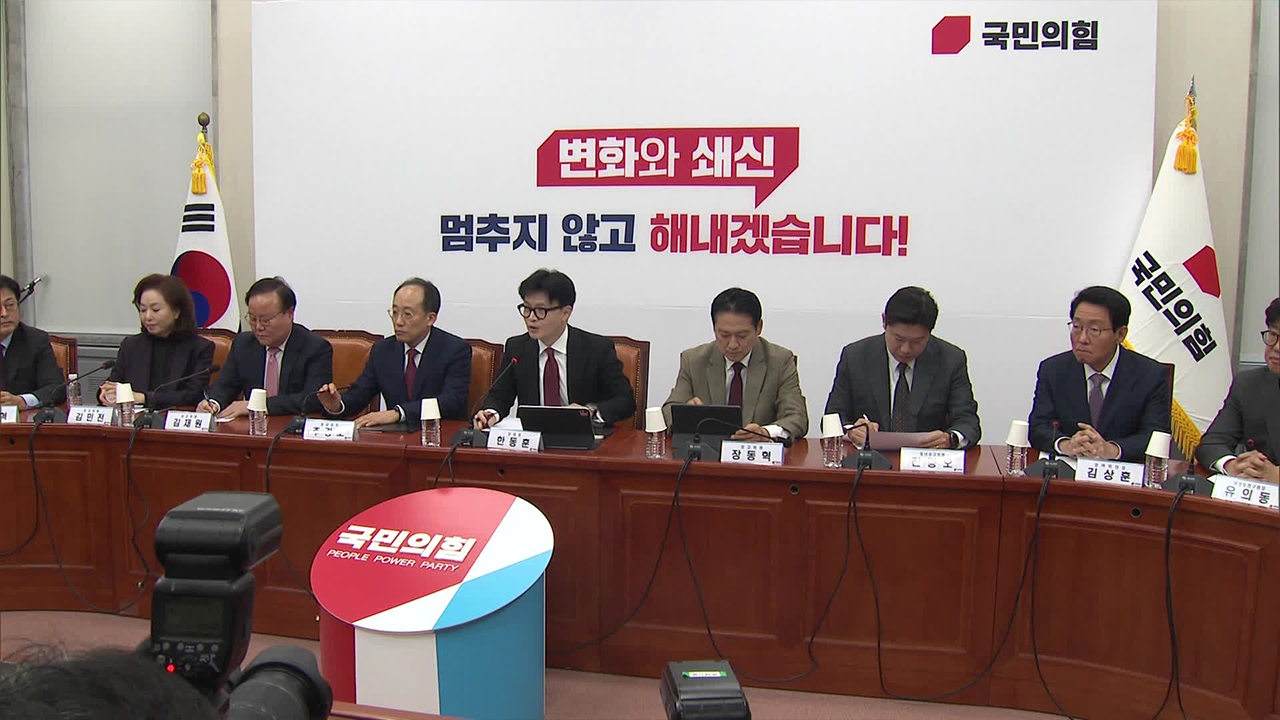E-cigarette tax loophole sparks debate over nicotine form and tax rates
입력 2024.11.14 (00:45)
읽어주기 기능은 크롬기반의
브라우저에서만 사용하실 수 있습니다.
[Anchor]
Electronic cigarettes are now facing new controversy over tax loopholes, following health risk concerns.
The tax rate on e-cigarettes can vary by up to 35 times depending on whether the nicotine is in liquid or solid form
As a result, changing the form of nicotine leads to absurdly low taxes being imposed.
Reporter Park Chan has the details.
[Report]
These are disposable electronic cigarettes available at convenience stores.
They look similar, but when disassembled, the forms of nicotine are different.
One type is a liquid form, where the liquid containing nicotine is absorbed into cotton.
The other product contains nicotine pellets that are designed to combine with a nicotine-free liquid when smoked.
[Electronic cigarette industry official/voice altered: "This solid nicotine cannot be used alone. It is the first time that solid nicotine has been combined with liquid electronic cigarettes."]
Both products can deliver the equivalent of two packs of regular cigarettes, and the liquid capacity is the same at 2ml, but there is a difference in the taxes imposed.
The solid-type electronic cigarette is taxed based only on the solid weight of 0.4g, while the liquid type is taxed based on the entire 2ml of liquid.
Based on the tobacco consumption tax, a pack of regular cigarettes costs 1,007 won.
The same amount of liquid-type electronic cigarettes costs 628 won, while heat-not-burn products cost about 641 won, but the solid type is only around 17 won.
Even when comparing electronic cigarettes alone, the tax difference is as much as 35 times.
Such differences could distort the future distribution of tobacco.
Currently, only natural nicotine is subject to tobacco-related taxes, and a bill to impose taxes on synthetic nicotine, which occupies most of the electronic cigarette market, is under discussion at the National Assembly.
If solid types continue to be favored, there are concerns that even if synthetic nicotine becomes taxable, it could evade taxes by being classified as solid.
[Lee Seong-kyu/Director of Korea Center for Tobacco Control Research and Education: "Since we cannot anticipate the strategies of tobacco companies, these processes are bound to be repeated. Companies will seek alternatives to find other paths within the market..."]
More than half of the price of cigarettes consists of taxes and fees.
How the taxation system for solid types is organized will inevitably have a significant impact on tax revenue and the scale of tobacco distribution.
This is KBS News, Park Chan.
Electronic cigarettes are now facing new controversy over tax loopholes, following health risk concerns.
The tax rate on e-cigarettes can vary by up to 35 times depending on whether the nicotine is in liquid or solid form
As a result, changing the form of nicotine leads to absurdly low taxes being imposed.
Reporter Park Chan has the details.
[Report]
These are disposable electronic cigarettes available at convenience stores.
They look similar, but when disassembled, the forms of nicotine are different.
One type is a liquid form, where the liquid containing nicotine is absorbed into cotton.
The other product contains nicotine pellets that are designed to combine with a nicotine-free liquid when smoked.
[Electronic cigarette industry official/voice altered: "This solid nicotine cannot be used alone. It is the first time that solid nicotine has been combined with liquid electronic cigarettes."]
Both products can deliver the equivalent of two packs of regular cigarettes, and the liquid capacity is the same at 2ml, but there is a difference in the taxes imposed.
The solid-type electronic cigarette is taxed based only on the solid weight of 0.4g, while the liquid type is taxed based on the entire 2ml of liquid.
Based on the tobacco consumption tax, a pack of regular cigarettes costs 1,007 won.
The same amount of liquid-type electronic cigarettes costs 628 won, while heat-not-burn products cost about 641 won, but the solid type is only around 17 won.
Even when comparing electronic cigarettes alone, the tax difference is as much as 35 times.
Such differences could distort the future distribution of tobacco.
Currently, only natural nicotine is subject to tobacco-related taxes, and a bill to impose taxes on synthetic nicotine, which occupies most of the electronic cigarette market, is under discussion at the National Assembly.
If solid types continue to be favored, there are concerns that even if synthetic nicotine becomes taxable, it could evade taxes by being classified as solid.
[Lee Seong-kyu/Director of Korea Center for Tobacco Control Research and Education: "Since we cannot anticipate the strategies of tobacco companies, these processes are bound to be repeated. Companies will seek alternatives to find other paths within the market..."]
More than half of the price of cigarettes consists of taxes and fees.
How the taxation system for solid types is organized will inevitably have a significant impact on tax revenue and the scale of tobacco distribution.
This is KBS News, Park Chan.
■ 제보하기
▷ 카카오톡 : 'KBS제보' 검색, 채널 추가
▷ 전화 : 02-781-1234, 4444
▷ 이메일 : kbs1234@kbs.co.kr
▷ 유튜브, 네이버, 카카오에서도 KBS뉴스를 구독해주세요!
- E-cigarette tax loophole sparks debate over nicotine form and tax rates
-
- 입력 2024-11-14 00:45:45

[Anchor]
Electronic cigarettes are now facing new controversy over tax loopholes, following health risk concerns.
The tax rate on e-cigarettes can vary by up to 35 times depending on whether the nicotine is in liquid or solid form
As a result, changing the form of nicotine leads to absurdly low taxes being imposed.
Reporter Park Chan has the details.
[Report]
These are disposable electronic cigarettes available at convenience stores.
They look similar, but when disassembled, the forms of nicotine are different.
One type is a liquid form, where the liquid containing nicotine is absorbed into cotton.
The other product contains nicotine pellets that are designed to combine with a nicotine-free liquid when smoked.
[Electronic cigarette industry official/voice altered: "This solid nicotine cannot be used alone. It is the first time that solid nicotine has been combined with liquid electronic cigarettes."]
Both products can deliver the equivalent of two packs of regular cigarettes, and the liquid capacity is the same at 2ml, but there is a difference in the taxes imposed.
The solid-type electronic cigarette is taxed based only on the solid weight of 0.4g, while the liquid type is taxed based on the entire 2ml of liquid.
Based on the tobacco consumption tax, a pack of regular cigarettes costs 1,007 won.
The same amount of liquid-type electronic cigarettes costs 628 won, while heat-not-burn products cost about 641 won, but the solid type is only around 17 won.
Even when comparing electronic cigarettes alone, the tax difference is as much as 35 times.
Such differences could distort the future distribution of tobacco.
Currently, only natural nicotine is subject to tobacco-related taxes, and a bill to impose taxes on synthetic nicotine, which occupies most of the electronic cigarette market, is under discussion at the National Assembly.
If solid types continue to be favored, there are concerns that even if synthetic nicotine becomes taxable, it could evade taxes by being classified as solid.
[Lee Seong-kyu/Director of Korea Center for Tobacco Control Research and Education: "Since we cannot anticipate the strategies of tobacco companies, these processes are bound to be repeated. Companies will seek alternatives to find other paths within the market..."]
More than half of the price of cigarettes consists of taxes and fees.
How the taxation system for solid types is organized will inevitably have a significant impact on tax revenue and the scale of tobacco distribution.
This is KBS News, Park Chan.
Electronic cigarettes are now facing new controversy over tax loopholes, following health risk concerns.
The tax rate on e-cigarettes can vary by up to 35 times depending on whether the nicotine is in liquid or solid form
As a result, changing the form of nicotine leads to absurdly low taxes being imposed.
Reporter Park Chan has the details.
[Report]
These are disposable electronic cigarettes available at convenience stores.
They look similar, but when disassembled, the forms of nicotine are different.
One type is a liquid form, where the liquid containing nicotine is absorbed into cotton.
The other product contains nicotine pellets that are designed to combine with a nicotine-free liquid when smoked.
[Electronic cigarette industry official/voice altered: "This solid nicotine cannot be used alone. It is the first time that solid nicotine has been combined with liquid electronic cigarettes."]
Both products can deliver the equivalent of two packs of regular cigarettes, and the liquid capacity is the same at 2ml, but there is a difference in the taxes imposed.
The solid-type electronic cigarette is taxed based only on the solid weight of 0.4g, while the liquid type is taxed based on the entire 2ml of liquid.
Based on the tobacco consumption tax, a pack of regular cigarettes costs 1,007 won.
The same amount of liquid-type electronic cigarettes costs 628 won, while heat-not-burn products cost about 641 won, but the solid type is only around 17 won.
Even when comparing electronic cigarettes alone, the tax difference is as much as 35 times.
Such differences could distort the future distribution of tobacco.
Currently, only natural nicotine is subject to tobacco-related taxes, and a bill to impose taxes on synthetic nicotine, which occupies most of the electronic cigarette market, is under discussion at the National Assembly.
If solid types continue to be favored, there are concerns that even if synthetic nicotine becomes taxable, it could evade taxes by being classified as solid.
[Lee Seong-kyu/Director of Korea Center for Tobacco Control Research and Education: "Since we cannot anticipate the strategies of tobacco companies, these processes are bound to be repeated. Companies will seek alternatives to find other paths within the market..."]
More than half of the price of cigarettes consists of taxes and fees.
How the taxation system for solid types is organized will inevitably have a significant impact on tax revenue and the scale of tobacco distribution.
This is KBS News, Park Chan.
이 기사가 좋으셨다면
-
좋아요
0
-
응원해요
0
-
후속 원해요
0
















이 기사에 대한 의견을 남겨주세요.